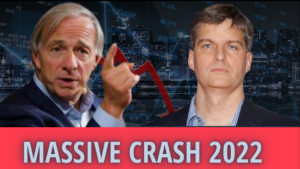View the video version of this post, here.
Ray Dalio has been warning us of a coming steep market crash, and experts like Ray are now point pointing exactly when and how to know that this crash will occur
But, We’ve also all heard the stories about people like Michael Burry, making Millions off the stock market during a crash. This incident was so famous that a movie was made about it, called “The Big Short.” And Michael Burry’s recent twitter post, Not only Michael Burry, but you can make impressive profits, if you know use lucrative strategies. But first, when do Dalio and Burry say this “mother of all crashes” will occur?
The bad news is that no one knows, we just know that another big market crash will occur someday, but I can share with you how to know exactly when the stock market has spiraled into a long-term crash versus a short-term pullback like that of 2020.
Hi Wealth friends and welcome back. If you’re not familiar with me, I worked for years with Fortune 500 CFO’s and financial consulting teams to help companies determine where they were making money. Now I use this knowledge to analyze and invest in the stock market. Over the years, I’ve discovered a clear signal pinpointing out that a crash is going to keep on going, down, down and more down, like those of 2001, 2008 and how to recognize a shorter steep pullback of 2020. Today, you’ll find that, despite the current bear market, if this crash of no return has begun. Or if it’s possible that this market could revive and turn back upward for the long-term.
But first, could give this video a thumbs up in return for my efforts bringing this information to you, it would be greatly appreciated, and while you’re at it, subscribe.
So, Let’s go and discover if the stock market, as of late June 2022, has already reached that point of no return. And then what you can do next to reap big profits!
But first, remember that this video is not financial advice but for entertainment only.
Now let’s talk about how to spot a stock market crash. First, a market “Downturn” is signaled through two consecutive daily charting candles with lower lows and lower highs. In looking at this chart of the S&P 500 Index fund SPY, there’s been plenty of those daily lower lows and lower highs occurring in 2022.
Next, we look for the signal that the market has floundered into a Bear Market: this happens when prices have fallen 20% or more for two months or more. And unfortunately bear markets can also accompany economic downturns such as Dalio’s warned recession. But receding in to a bear market doesn’t yet signal that a long-term crash has begun. We can see on this chart of the SPY S&P 500 ETF that this index entered a bear market in June of this year! The recent high of $478 was reached on January 4th 2022, and the recent low was reached on June 17th of $365. This was a 24% pullback! But, you ask, can we still recover this year from bear market downturn? So, let’s find out.
A market crash can be first led by a downturn in the S&P 500 Index or the Nasdaq’s faster moving “growth stocks.” And this year, the Nasdaq has pulled back much lower as you can see by the blue line on this chart.
I tend to watch both the S&P 500 index, by following the related ETF, SPY, and the Nasdaq, through it’s related ETF, QQQ. But today, we’re talking about a potential general overall market crash, so we will continue to focus on the S&P 500.
How do you spot this market crash? Next I’ll show you how history has shown exactly how to do just that.
A market crash is easy to spot if you have your broker’s charting program set up with the following Exponential Moving Averages: a 25-day, a 50-day and a 100-day moving average. Plus, your chart needs to be displaying weekly candlesticks. This means that each candlestick is reflecting one week’s price movement for either the SPY and QQQ ETFs.
Every single time, you’ll find that a longer-term market crash, that’s going to keep on dropping, flashes when the 25-day ema moving average crosses over the 50- and 100-day moving averages. Remember that weekly candlesticks reflect investors’ strong market sentiment, so they are the candlestick timeline to follow.
Let’s take a look at the exponential moving average crossovers for 2000, 2008 and 2020, and so I can show you when each crash flashed, and then we can compare this to today’s movements in 2022. You can see these EMA crossovers occur during 2001 and 2008, but not in 2020. This meant that that the 2020 crash would only be a shorter-term market correction. And sure enough it lasted for only about one month!
Now that you know how to spot a deeper and longer-term stock market crash, exactly how do you profit from this crash?
One of the easiest ways to profit from a crash is by trading an inverse ETF, such as the: SDS which is the ultra-inverse/bear (or 2x) of the SPY, or the QID which is the 2x inverse/bear of the QQQ. You’ll want to enter an inverse ETF that it has a large average volume of daily trading so that you can quickly trade in and out of the fund, when needed. You can track the volume visually on the chart of through the ETF’s Yahoo Finance Profile. You can see that here in looking at the green and red volume bars showing below on the one-year chart for the SDS. Just be careful with these ETFs though, because they can drop as quickly as they rise!
Currently, we have a significant opportunity to profit from an inverse ETF trade. In 2008 at the start of this last major stock market crash, SDS was $1048 per share and increased to $1517 per share in one month. Obviously, the initial cost of $1048 would limit the number of share the average retail investor could afford to buy. Currently SDS is around $50 per share, which is a much more doable price.
Or, if you want to take a more conservative approach, you can trade the SH ProShares Short S&P 500 ETF which is currently in the $16 range, and is a direct inverse for the S&P 500. You can see here the chart for the Proshares Short SH ETF compared to the SPY ETF shown as the blue line. As the SH moves up, the SPY moves down!
I always like to be in an inverse ETF Trade when the stock market is pulling back, and the VIX is elevated above 20. The VIX signals investors’ fear, and the higher that VIX number the better. This YTD chart of the VIX with daily candlesticks shows that on the low side the VIX only went down to $19 per share, and on the high side as high as $35.
When watching an ETF for a long-term investment or for a market crash, I always setup my charting with Heikin-Ashi candlesticks. This type of charting candlestick makes it much easier for you to spot market trends. This type of candlestick uses a fascinating arithmetic scheme, and I made an entire video on Heikin-Ashi candlesticks that I will link at the end of this video, and in the description below.
So when do you get out of a stock market crash inverse ETF?
The timing of exactly when you jump out of an inverse trade is a personal decision regarding how long you want to hang on for more profit, but risk a potential market reversal. Once you’ve entered an inverse ETF trade, it’s best to switch to watching its chart as a daily candlestick view, or even the four-hour candlestick view as the major uptrends can occur in shorter spurts, of often 8 toL 12 days. This means you’ll want to make a decision at the time of entering a trade at what price, or type of price movement, you plan to exit the trade both on the upside or downside.
As the stock market has historically over its entire history increased in value over time, I do like to get back into my wide market ETFs, such as, SPY, VOO, QQQ or XLK, once the market corrects.
But you may ask, how to determine a market bottom for the S&P 500? No one has figured that one out yet, but you can look at historic pullback percentages to determine points at to reenter or add to your positions.
Here are points at which the market previously turned back up, and you can potentially allocate funds to reenter at each point.
In 2020 the stock market pulled back 36%, but that wasn’t a long-term market correction, so we won’t use that percentage.
In the 2001 stock market, pulled back 46%. And, in the most severe modern-day crash, the stock market pulled back 56% from the recent high.
The S&P 500 ETF’s SPY reached a high of $479 per share on January 4th of 2022. A 46% drop would put the price at $258 per share. A 56% drop would put the price at $210 per share. These would all be potential reentry points to consider. And if you want to really be conservative, reserve funds to reenter at a 79% drop which would mean a price of $100 per share.
I am making updated videos for each of these ETFs for 2022, regarding how to spot a crash for each, and how to determine a potential safe reentry point based on historic pullbacks. So watch out for each.
I’d love to hear your comments. Now, go here to view our Market Crash Video Playlist.


It’s actually very complicated in this active life to listen news on Television,
therefore I only use world wide web for that purpose,
and get the latest information.